
Bernice has split days off, Thursday’s and Saturdays. She left for work; Mark took us for a tour of a modern dairy. Casey Johnson’s Dairy milks and holds some of the cows and calves that belong to Mark and possibly other area farmers. Mark has a pasture full of young bulls and cows, and they have some kind of cooperative arrangement. Every cow is numbered and tagged. This barn holds 100 cows.
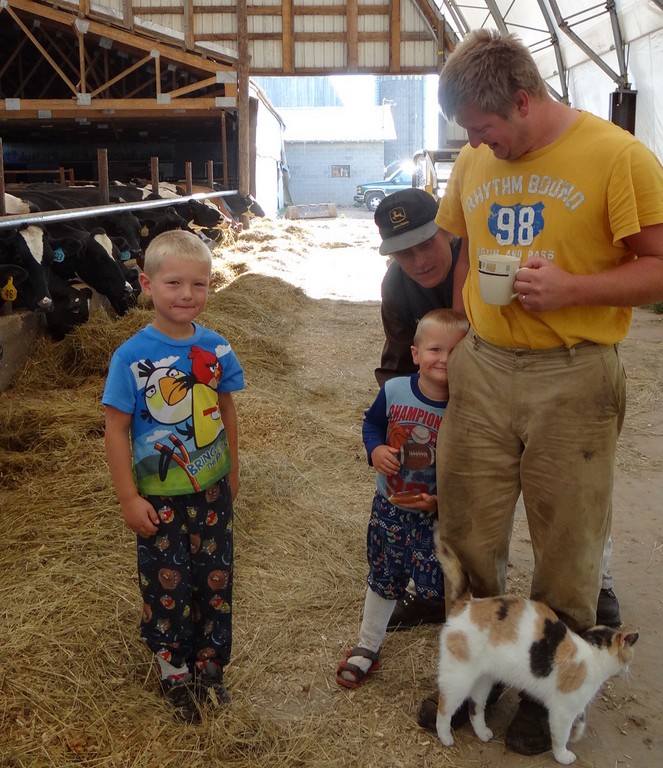
Casey had just fed the cows and his boys their breakfast before we arrived. His wife had already left for work. In Casey’s words, you have to love work and hate money to be a farmer of any kind. The oldest son went to finish a project. He is only six but he can operate a power drill. He is drilling holes in a board, collecting the sawdust to sell. Of course, we all chuckled. Not much different from the lemonade and zuchinni stands of city kids, I expect.
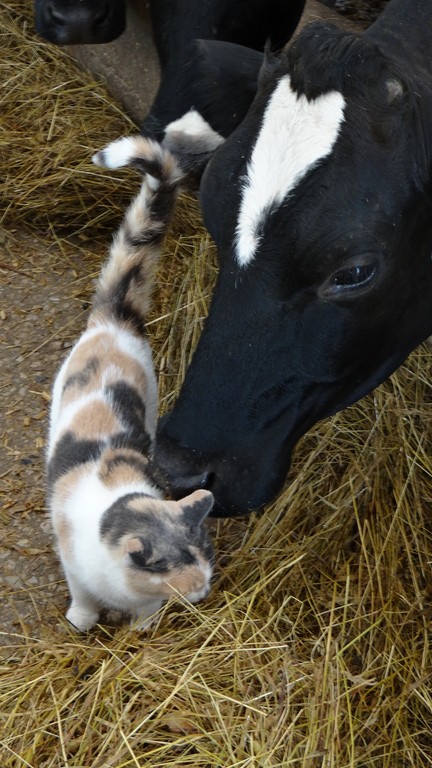
If you’ve never been in an old-time dairy barn, you know immediately how innovative and clean this operation is. The food is on clean dry cement and has no chance of mixing with muck, manure or anything dirty. The cows reach for the feed. When it is out of reach, a small tractor plows it back within reach. It isn’t only hay. A sweet-smelling ground mix of corn and barley is also fed with the hay. The cat gets a bath from the cows who seem to like her just fine.

The cows are lounging around chewing their cud in the middle of the barn on sand. I couldn’t believe they used sand. It is cleaner than hay. There is no other place in the barn to lie down. The stanchions are positioned so they have to go in front first to rest so most of the manure goes in the trough.
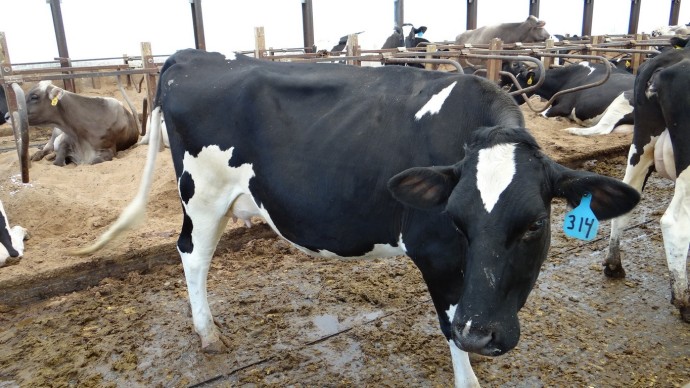
In the trough you can see a crevice under this cow. Two steel cables are operated mechanically to lift up and scrape the manure to one side where it is then machine scraped to the end of the building for the fertilizer sales. Easy, clean.
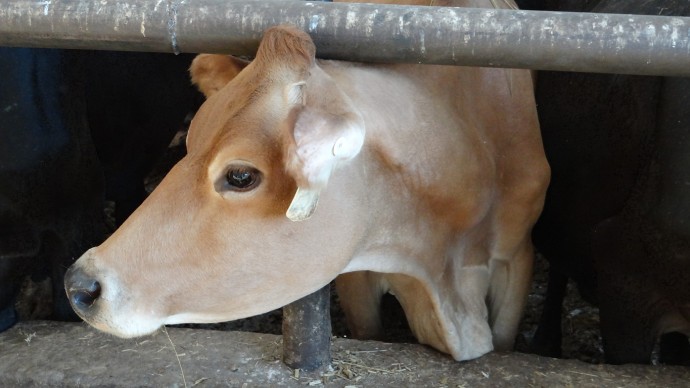
The cows are a mix of guernseys, (above) the black and whites are holstiens, and a few mixed breeds. (I hope I have that right. It has been a long time.)
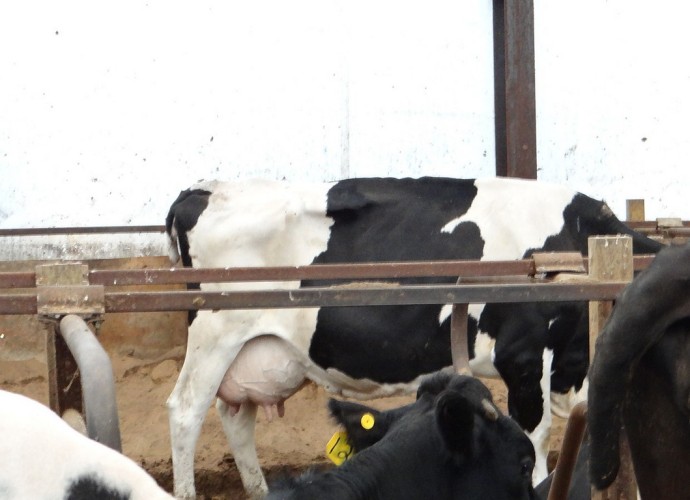
You can see how full their udders are. They get milked twice a day, 7 days a week. No days off for a dairy farmer.

This cow didn’t get de-horned. My youngest daughter raised dairy goats and the same theory prevails. Horned animals may fight and hurt each other, so they are de-horned. We both hated de-horning. Mark contends that a cow with horns seems more content.

At milking time, Casey gets behind them and gets them moving. They walk through the bath area.
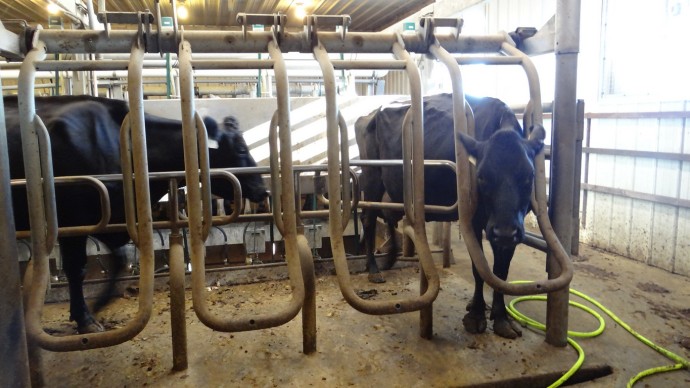
The cows load into the milk room automatically. They push a gate aside to get into the stanchion. The lead cow knows to go all the way to the end, not a spot can be missed. They cannot turn around or pass another cow. It is very controlled.
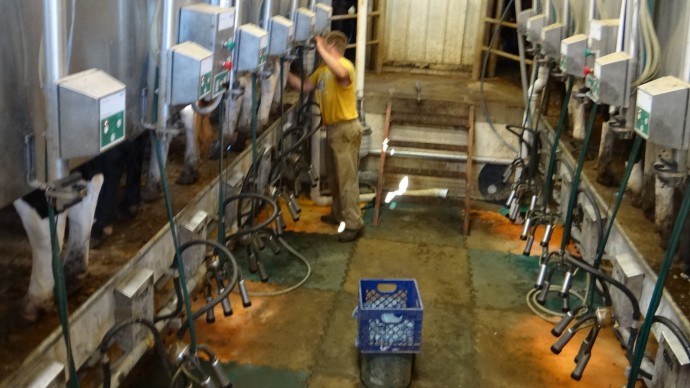
Down in the pit, with seven cows on each side, Casey wipes down all the udders before attaching the milking machines.
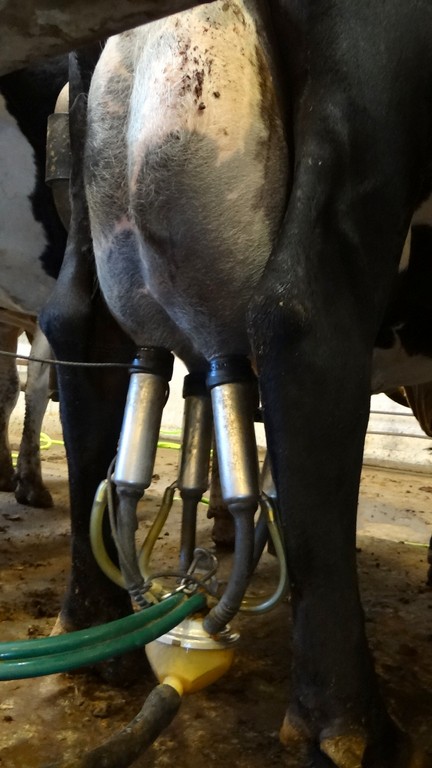
It takes only 3 and a half minutes to milk the cow. The machine records the amount of milk from each cow. The dairyman knows what cow produced how much milk. Older cows give more milk than younger ones. They live about 20-25 years so they know their place in the line-up like school children going to the same desk.

Turned loose with slack udders, they return to the feed barn. The muddy spot they walk through has a powerful bacteria killer that keeps their feet from tracking in disease carrying pathogens.
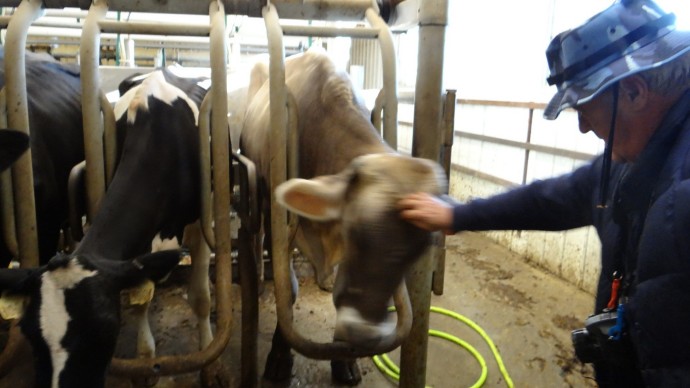
City boy, Jim, wasn’t too sure he wanted to go to a dairy, but even he was surprised how odorless the barn was. OMIGOD. Not like days of old. At school, especially on the bus, your nose knew what kids milked cows before school each morning. We bought milk from Bernice’s family, they had dairy cows. They didn’t smell of barn. Maybe certain families didn’t have good washing machines, or didn’t change clothes before coming to school, or maybe they didn’t bathe frequently enough.
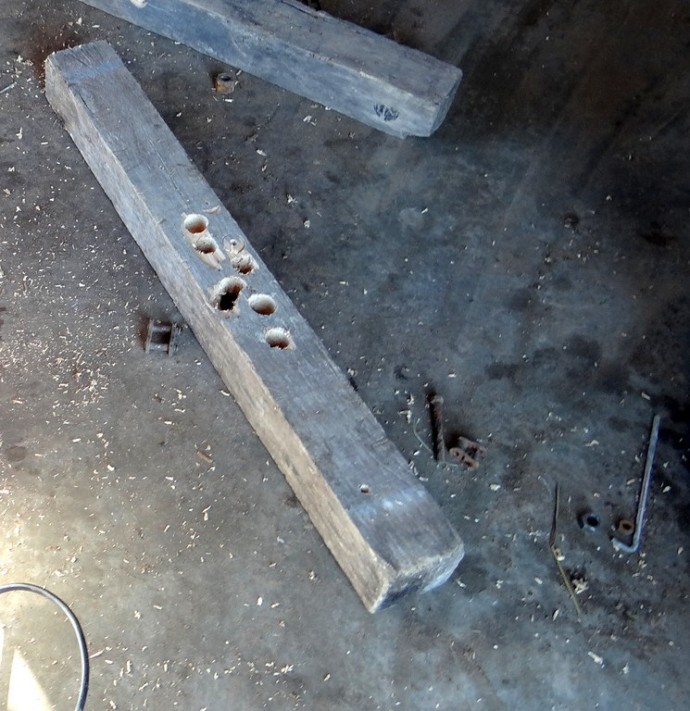
On the way to the calf barn, we stumbled upon the sawdust operation. The little guy was off playing somewhere else, so we didn’t catch him in action.
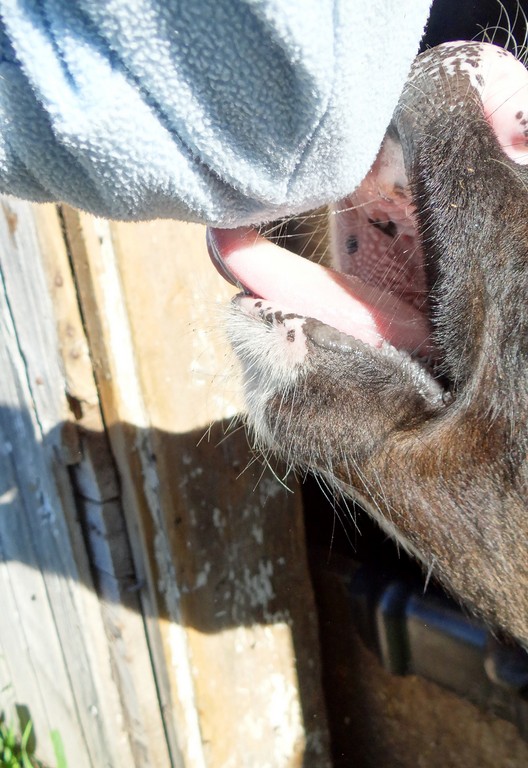
I kept feeding the calves grass and this one calf liked my fuzzy jacket. I finally got a photo of that raspy tongue reaching out to grab my sleeve.

Two of Mark’s calves are separated out because they have the scours, (dysentery). Some don’t live through it.
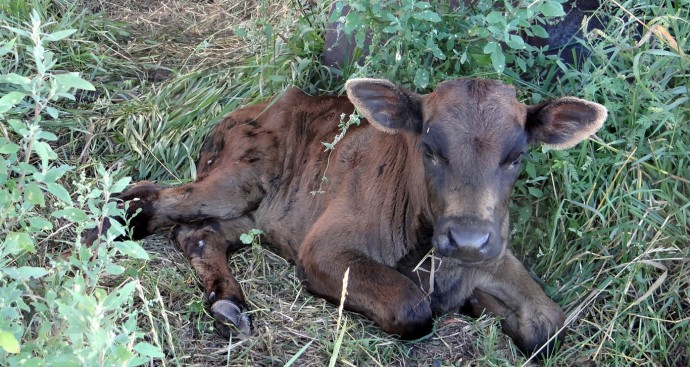
This healthy calf is recuperating from a leg wound. His hind leg is swollen and hurt from getting entangled in some machinery. He can hobble around the yard and will survive.

Mark pointed out how hay is handled. An expensive machine that hooks to the back of a tractor drives the round hay bales into a plastic sheath while machine drying it so it cannot mold. The green food has a higher nutrition rate. No more expensive barns with hay lofts. The hay can lay on the ground (or inside under during winter) and be available constantly by peeling back the plastic.
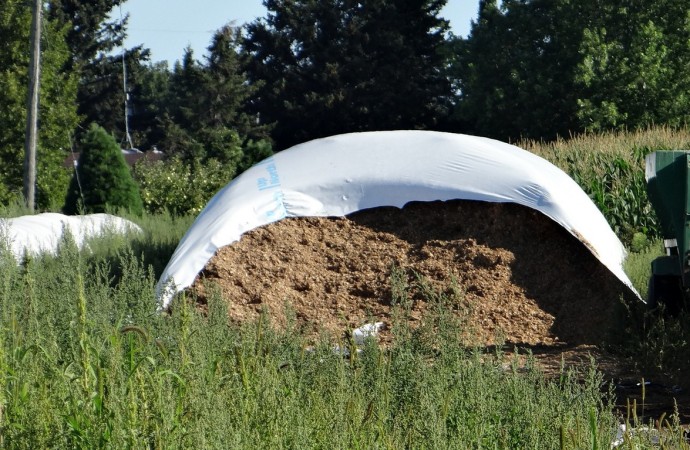
Corn and barley silage is handled in a different type of bag called a Band-it with the same principle. Quite an operation.
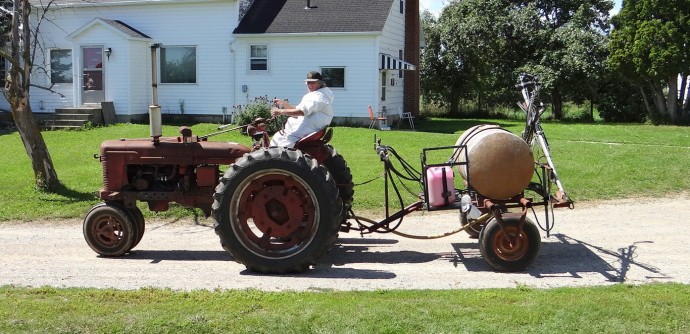
We returned to the motor home for breakfast and some work on our electrical connection. Mark took off on his oldest tractor to do some spraying. I didn’t know you needed four tractors to be an efficient farmer.

The electrical problem was tricky and we blew some major fuses. Jim had to take off for Escanaba to get help. So, he didn’t come with Bernice and I to Marie’s house. The road is named for her family, Gaber Rd.
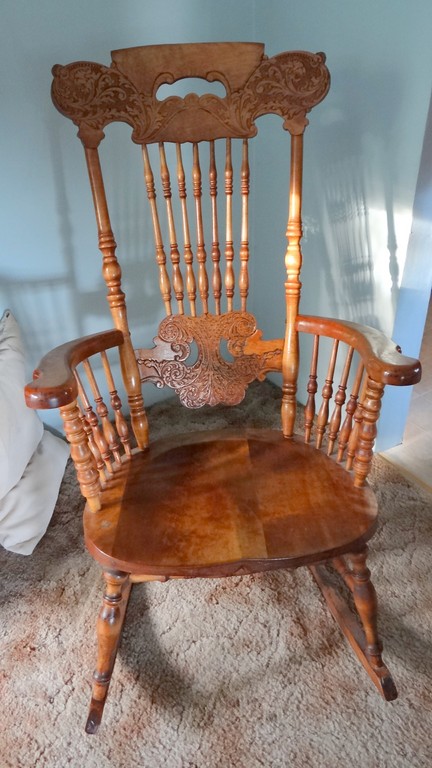
Like Bernice, she loves antiques. I took a picture of this family heirloom, a beautifully carved rocking chair.

I had to take a picture of this old clothes line pole. My mom was short and the lines had to be reachable. So, like Marie’s we always had a pole to lift the wet clothes up high off the ground once you got them hung. What a hoot.
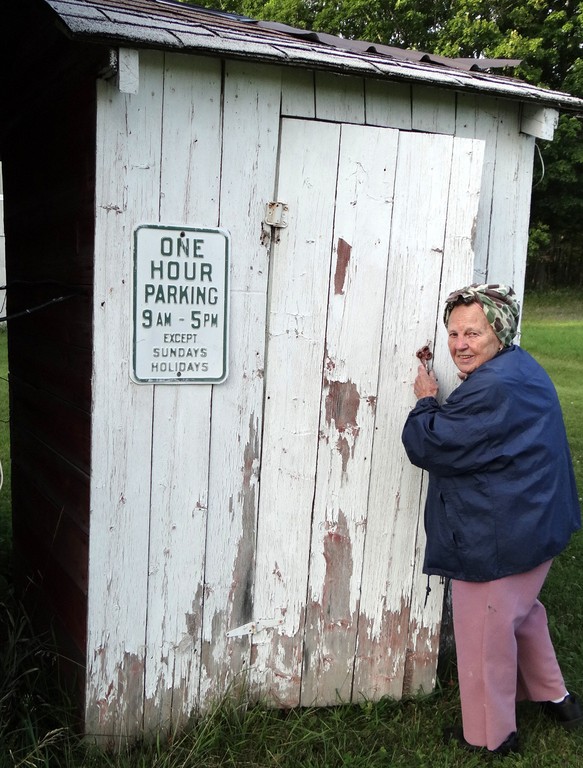
Her house is modernized but she keeps the old house “outback”, “…just in case..” Pipes freeze, emergency plumbing is expensive…

We never had such a fancy place as this two holer. Marie paints everything, her favorite color, baby blue.

Through Marie’s half section of land, this line was put through. She sold some land and now only has two forty acre pieces. We took a drive out Electric Line Rd. to Bernice’s Camp.

Several deer blinds are set up along the road, and other camps besides Bernice’s Camp. She hunts almost every year and get’s her deer. Hunting season in November is like a big holiday. All their friends gather and use the camp. And when the deer come in they dress and hang them and out comes the whiskey and beer for a big toast. The women cook up a storm and it is party time. It reminded me of that movie and play, Escanaba In Duh Moonlight. When I mentioned that, Bernice told me how offensive that movie was to Yoopers. My dad was a true hunter. He would not understand the change in hunting practices, of setting up a feed station, then killing deer from a blind.
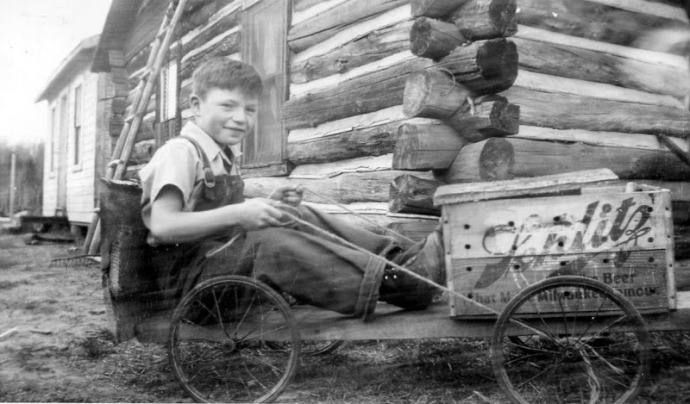
This is our house that burned down. The building barely visible in the back is an old gas station building my dad owned. He hauled it on a logging dray to our property and turned it into a hunting lodge during hunting season. We saw many a huge buck leave our property on somebody’s fender. My dad hunted rifle and bow season and always got his buck, plus any number of others he wanted for table meat when the game warden wasn’t looking.
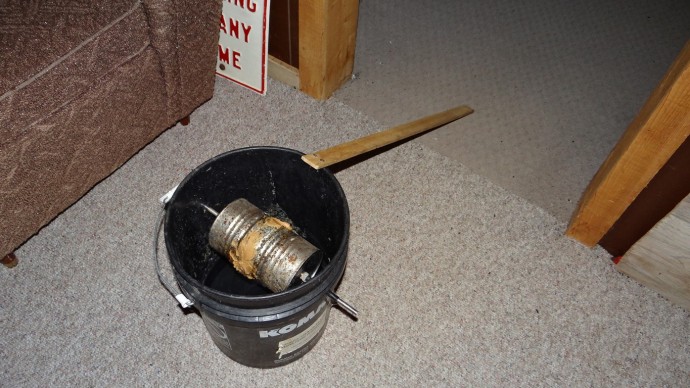
At Bernice’s Camp, she wanted to clean out the mouse traps.

She put clean water in the buckets and fresh peanut butter on the can. Very effective.

Her camp has no electricity. The double bed sized bunk beds are welded angle iron and regular boxsprings and mattresses. Very comfy. They keep anything that spoils in the old fashioned metal bread boxes so mice can’t get into it. It was a fun day. Bernice took me to the Island Casino where she works and bought ice cream treats, (you know where that ice cream came from,) before we dropped off Marie and headed home.
No comments:
Post a Comment